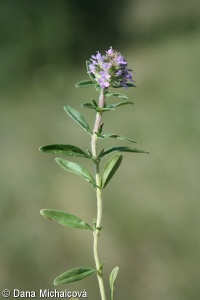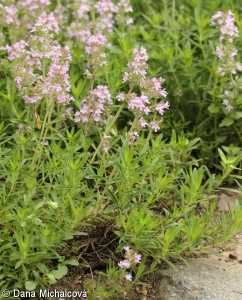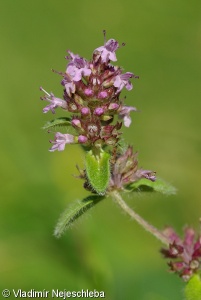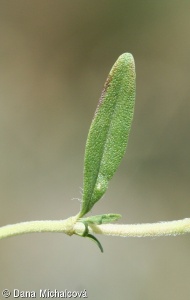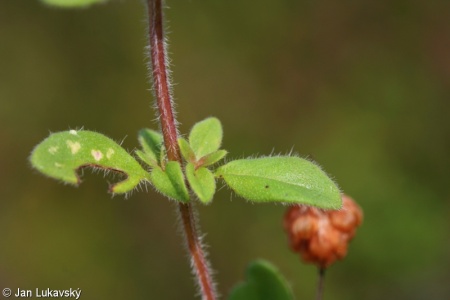Thymus pulegioides subsp. pannonicus
Data
download factsheetLeaf
-
Leaf type (woody plants only): Sclerophyllous?
Leaf type (woody plants only)
Functional leaf types in woody plants, often used for physiognomic classification of forest and scrub vegetation, are distinguished based on their morphology, anatomy and life span. Most angiosperm woody plants of the central-European flora have broad deciduous or semi-deciduous leaves with a large specific leaf area. The other leaf types, with rare exceptions (Larix), are perennial and usually called evergreen. Needle-like and scale-like leaves occur in conifers and some species of Ericaceae. Sclerophyllous leaves are flat but have a strongly developed sclerenchyma, which causes their toughness. They are usually small coriaceous leaves with small specific leaf area, adapted to dry climate. Laurophyllous leaves are larger and thinner than sclerophyllous leaves and have less sclerenchyma. In most cases, they are dark green, smooth and shiny. These leaves are adapted to year-round humid climates with mild winters. A few species that are difficult to assign to these categories are classified as “special type”.
The data on functional leaf types were compiled from Chytrý et al. (2020), Štěpánková & Grulich (2020), floras of some other countries, and complemented by original observations.
Categories
- Needle-like
- Scale-like
- Broad deciduous or semi-deciduous
- Sclerophyllous
- Laurophyllous
- Other
Data source and citation
Axmanová, I. (2022). Leaf type. – www.FloraVeg.EU.
Further references
Chytrý M., Tichý L., Hennekens S.M., Knollová I., Janssen J.A.M., Rodwell J.S., … Schaminée J.H.J. (2020). EUNIS Habitat Classification: expert system, characteristic species combinations and distribution maps of European habitats. Applied Vegetation Science, 23(4), 648–675. https://doi.org/10.1111/avsc.12519 – Version 2021-06-01: https://doi.org/10.5281/zenodo.4812736
Štěpánková P. & Grulich V. (2020) Functional leaf type in woody plants. – www.pladias.cz. -
Leaf phenology (woody plants only): Evergreen?
Leaf phenology (woody plants only)
The leaves of different woody plant species have distinct phenological patterns. Most species of Central European woody plants have winter-deciduous leaves, while a small proportion have evergreen (persistent-green) leaves. Semi-deciduous leaves are rare, occurring mainly in cultivated species. The category of winter semi-deciduous leaves includes only those leaves that are at least partly green in winter, but not marcescent leaves, which die in autumn and remain attached to the parent plant in a dry state through the winter (e.g. young individuals of Quercus).
Data on leaf deciduousness were compiled from Klotz et al. (2002), Tavşanoğlu & Pausas (2018), Chytrý et al. (2020), Štěpánková & Grulich (2020), floras of some other countries, and complemented by original observations.
Categories
- Evergreen
- Winter deciduous
- Winter semi-deciduous
- Drought semi-deciduous
Data source and citation
Axmanová, I. (2022). Leaf phenology. – www.FloraVeg.EU.
Further references
Chytrý M., Tichý L., Hennekens S.M., Knollová I., Janssen J.A.M., Rodwell J.S., … Schaminée J.H.J. (2020). EUNIS Habitat Classification: expert system, characteristic species combinations and distribution maps of European habitats. Applied Vegetation Science, 23(4), 648–675. https://doi.org/10.1111/avsc.12519 – Version 2021-06-01: https://doi.org/10.5281/zenodo.4812736
Klotz, S., Kühn, I. & Durka, W. (2002). BIOLFLOR – Eine Datenbank zu biologisch-ökologischen Merkmalen der Gefäßpflanzen in Deutschland. Schriftenreihe für Vegetationskunde, 38, 1–334.
Štěpánková P. & Grulich V. (2020). Leaf deciduousness in woody plants. – www.pladias.cz.
Tavşanoğlu, Ç., & Pausas, J. (2018). A functional trait database for Mediterranean Basin plants. Scientific Data, 5, 180135. https://doi.org/10.1038/sdata.2018.135
Fruit, seed and dispersal
-
Dispersal mode: Local non-specific dispersal?
Dispersal mode
Dispersal mode (dispersal syndrome, dispersal type) characterizes plant dispersal ability. It is represented by following categories: (i) local non-specific dispersal, which combines self-dispersal (autochory) and dispersal initiated by wind, where diaspores do not have any efficient special dispersal features, including several dispersal modes (namely ballochory, blastochory, boleochory, barochory); (ii) myrmecochory (ant dispersal); (iii) wind dispersal (anemochory), diaspores have special dispersal features such as hem, pappus, trichomes, dusty seeds or the species are tumbleweeds; (iv) animal dispersal includes dyszoochory, i.e. diaspores foraged by animals, which sometimes hide them as stock; (v) endozoochory, i.e. dispersal in animal gastrointestinal tract, and (vi) epizoochory, i.e., dispersal of diaspores attached on animal fur; special case is the (vii) anthropochory, i.e. human dispersal and (viii) hydrochory (water dispersal). Please note that hydrochory is not considered in the dispersal distance classes classification.
The dispersal modes are mainly estimated from species' morphological characteristics.
Categories
- Local non-specific dispersal
- Myrmecochory
- Anemochory
- Dyszoochory
- Endozoochory
- Epizoochory
- Anthropochory
- Hydrochory
Data source and citation
Lososová Z., Axmanová I., Chytrý M., Midolo G., Abdulhak S., Karger D.N., Renaud J., Van Es J., Vittoz P. & Thuiller W. (2023). Seed dispersal distance classes and dispersal modes for the European flora. Global Ecology and Biogeography, 32(9), 1485–1494.
Further references
Vittoz P. & Engler R. (2007). Seed dispersal distances: a typology based on dispersal modes and plant traits. Botanica Helvetica, 117, 109–124.
-
Dispersal distance class: 1?
Dispersal distance class
Dispersal distance classes are represented by ordered classes from 1 to 7, where classes 1 to 6 represent a gradient from short-distance dispersal to long-scale dispersal. The last class represents the dispersal mediated by humans. For species of the last class the assignment to the previous six classes and natural dispersal mode are given. The assignment of individual plants follows Lososová et al. (2023), a dataset prepared using the adjusted methodology of Vittoz & Engler (2007).
To assign plants into dispersal distance classes, several plant characteristics were obtained from various sources, namely plant height, life form, predominant dispersal mode, seed mass, typical habitat, plant geographical origin and information on dispersal by humans. In contrast to the original approach of Vittoz & Engler (2007), definitions of the dispersal distance classes were slightly modified.
Class 1 contains species shorter than 0.3 m. Their seeds do not have any specific dispersal features. Species are mostly self-dispersed, although seed dispersal can be initiated by wind, e.g., by shaking the fruit, which causes the diaspore to fall down. Class 2 is the most species-rich, including species with non-specific local dispersal strategy taller than 0.3 m. Class 3 includes ant-dispersed (myrmecochorous) species and wind-dispersed (anemochorous) forest herbs and dwarf shrubs. Class 4 is the least species-rich, including less efficient wind-dispersed woody plants and tumbleweeds. Class 5 includes wind-dispersed herbs and shrubs of open habitats and wind-dispersed trees with more efficient dispersal units (with trichomes). Class 6 includes species with different modes of animal dispersal. They can be dyszoochorous (i.e., foraged by animals, which sometimes hide them as stock), endozoochorous (i.e., dispersal in animal gastrointestinal tract), and epizoochorous (i.e., dispersal on animal fur). Finally, class 7 contains human-dispersed (antropochorous) species.
The species of the last class are also classified into one of the previous six classes based on their natural dispersal mode. Only classes 1-6 can be used in studies at the landscape scale where it is assumed that most species disperse naturally. All seven classes can be used in studies at a broader geographical scale where rare events of long-distance human dispersal are important.
Classes
- Class 1. Small plants without any specific dispersal features. Mean dispersal distance: 0.1–1 m.
- Class 2. Tall plants without any specific dispersal features. Mean dispersal distance: 1–5 m.
- Class 3. Wind-dispersed plants of forest understorey and ant-dispersed plants. Mean dispersal distance: 2–15 m.
- Class 4. Tumbleweed and wind dispersed trees and shrubs without trichomes. Mean dispersal distance: 40–150 m.
- Class 5. Wind dispersed trees and shrubs with trichomes and wind dispersal plants of open habitats. Mean dispersal distance: 10–500 m.
- Class 6. Animal dispersed plants. Mean dispersal distance: 400–1500 m.
- Class 7. Human dispersed plants. Mean dispersal distance: 500 –5000 m.
Data source and citation
Lososová Z., Axmanová I., Chytrý M., Midolo G., Abdulhak S., Karger D.N., Renaud J., Van Es J., Vittoz P. & Thuiller W. (2023). Seed dispersal distance classes and dispersal modes for the European flora. Global Ecology and Biogeography, 32(9), 1485–1494.
Further references
Vittoz P. & Engler R. (2007). Seed dispersal distances: a typology based on dispersal modes and plant traits. Botanica Helvetica, 117, 109–124.
Habitat and sociology
-
Syntaxon
-
?
Diagnostic species of phytosociological classes
Diagnostic species are characterized by a concentration of their occurrence in the stands belonging to the target vegetation unit while being rare or absent in other vegetation units. For the European vegetation classes of the EuroVegChecklist (Mucina et al. 2016), the list of these species was compiled from various European literature sources, especially syntaxonomic monographs and revisions containing extensive synthetic phytosociological tables. Expert opinion from EuroVegChecklist authors was used to judge problematic cases. Some species were assigned to more than one class. Unlike for the EUNIS habitat types, no statistical approach was used to determine diagnostic species for European vegetation classes.
Data source and citation
Mucina L., Bültmann H., Dierßen K., Theurillat J.-P., Raus T., Čarni A., … Tichý L. (2016). Vegetation of Europe: Hierarchical floristic classification system of vascular plant, bryophyte, lichen, and algal communities. Applied Vegetation Science, 19(Suppl. 1), 3–264. https://doi.org/10.1111/avsc.12257 (Mucina et al. 2016, version 3, 2024-01-01)
-
Broad habitat
-
Occurrence in broad habitats: Grassland (non-alpine, non-saline)?
Occurrence in broad habitats
Species association to broadly defined habitats is based on species occurrences reported for finer units, either vegetation types or habitats. We compiled available data from several sources, Sádlo et al. (2007), Mucina et al. (2016), Guarino et al. (2019). Final list of habitats include 18 broad habitats.
Categories
- Marine
- Coastal saltmarsh
- Coastal beach, dune or shingle
- Coastal cliff
- Aquatic
- Spring
- Wetland
- Mire
- Grassland (non-alpine, non-saline)
- Alpine-subalpine and arctic grassland
- Saline vegetation
- Semi-desert
- Heathland
- Oromediterranean scrub
- Scrub
- Forest
- Sparsely vegetated (incl. rock and scree)
- Synanthropic
Data source and citation
Axmanová, I. (2022). Broad habitat. – www.FloraVeg.EU.
Further references
Guarino, R., La Rosa, M. & Pignatti, S. (Eds) (2019). Flora d'Italia, volume 4. Bologna: Edagricole.
Mucina, L., Bültmann, H., Dierßen, K., Theurillat, J.-P., Raus, T., Čarni, A., … Tichý L. (2016). Vegetation of Europe: Hierarchical floristic classification system of vascular plant, bryophyte, lichen, and algal communities. Applied Vegetation Science, 19(Suppl. 1), 3–264. https://doi.org/10.1111/avsc.12257
Sádlo, J., Chytrý, M. & Pyšek, P. (2007). Regional species pools of vascular plants in habitats of the Czech Republic. Preslia, 79, 303–321.
Distribution
-
Continentality: 8?
Continentality
Continentality degree is derived from the position of species distribution range on the gradient from oceanic Western Europe to continental Middle Asia. The concept and data were taken from Berg et al. (2017), who revised and corrected a previous system of indicator values for continentality developed by Ellenberg et al. (1991). Higher values on the ordinal scale from 1 to 9 indicate species distributed in more continental areas. The species that extend over more than four regions assigned to different continentality classes as defined by Jäger (1968) are considered to be indifferent unless their lower continentality border is located in the regions assigned to continentality class 2 or higher.
Data source and citation
Berg C., Welk E. & Jäger E. J. (2017). Revising Ellenberg’s indicator values for continentality based on global vascular plant species distribution. Applied Vegetation Science, 20(3), 482–493. https://doi.org/10.1111/avsc.12306
Further references
Ellenberg H., Weber H. E., Düll R., Wirth V., Werner W. & Paulißen D. (1991). Zeigerwerte von Pflanzen in Mitteleuropa. Scripta Geobotanica, 18, 1–248.
Jäger E. J. (1968) Die pflanzengeographische Ozeanitätsgliederung der Holarktis und die Ozeanitätsbindung der Pflanzenareale. – Feddes Repertorium 79: 157–335. -
Continentality amplitude: 5?
Continentality amplitude
The concept and data were taken from Berg et al. (2017), who revised and corrected a previous system of indicator values for continentality developed by Ellenberg et al. (1991). Continentality degree is derived from the position of species distribution range on the gradient from oceanic Western Europe (class 1) to continental Middle Asia (class 10). Consequently, continentality amplitude corresponds to the number of phytogeographic continental classes where given species is distributed.
Data source and citation
Berg C., Welk E. & Jäger E. J. (2017). Revising Ellenberg’s indicator values for continentality based on global vascular plant species distribution. Applied Vegetation Science, 20(3), 482–493. https://doi.org/10.1111/avsc.12306
Further references
Ellenberg H., Weber H. E., Düll R., Wirth V., Werner W. & Paulißen D. (1991). Zeigerwerte von Pflanzen in Mitteleuropa. Scripta Geobotanica, 18, 1–248.
Jäger E. J. (1968) Die pflanzengeographische Ozeanitätsgliederung der Holarktis und die Ozeanitätsbindung der Pflanzenareale. – Feddes Repertorium 79: 157–335. -
Country-based map: Euro+Med Plantbase
No subordinate taxa were found for this item.


